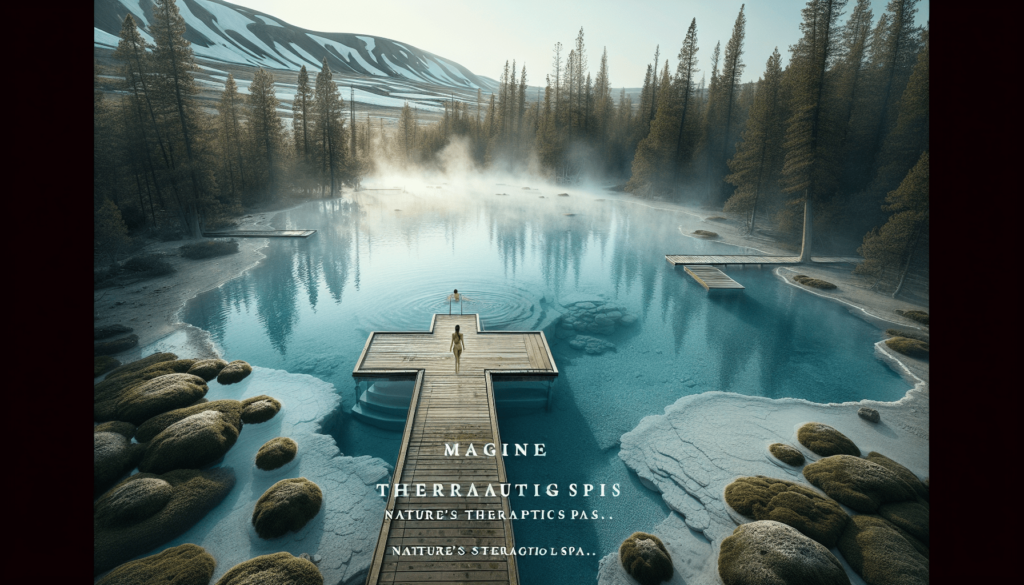Imagine yourself surrounded by nature, the warm sunlight kissing your skin as you stand at the edge of a magical hot spring. Your mind races with curiosity as you contemplate diving into the refreshing waters. But before taking the plunge, you wonder, can you go swimming in a hot spring? In this article, we will explore the various factors that determine whether or not diving into a hot spring is a safe and delightful experience.
What are hot springs
Hot springs are natural bodies of water that are heated by geothermal heat from the earth’s crust. These unique and fascinating features occur when groundwater is heated by rocks deep underground and rises to the surface, bringing with it various minerals and elements. Hot springs can be found all over the world and have been enjoyed for their therapeutic and recreational benefits for centuries.
Definition of hot springs
Hot springs are bodies of water that have temperatures higher than the average ambient air temperature. They are characterized by having heated water that originates from underground geothermal sources. The temperature of hot springs can range from just a few degrees above the average air temperature to scalding hot temperatures that require caution and regulation.
Formation of hot springs
Hot springs form when water is heated deep within the earth’s crust and rises to the surface. This heating process occurs when groundwater comes into contact with hot rocks, often associated with volcanic activity or tectonic plate movement. As the water travels through cracks and fissures in the earth, it absorbs various minerals and elements, which gives hot springs their unique properties and potential health benefits.
The temperature of hot springs
Hot springs temperature range
The temperature of hot springs can vary greatly, ranging from lukewarm to extremely hot. The specific temperature of a hot spring mostly depends on the source and depth of the geothermal activity. Some hot springs may be comfortable for swimming with temperatures around 35-40 degrees Celsius (95-104 degrees Fahrenheit), while others may be too hot for direct contact and require regulation or cautionary measures.
Effects of temperature on the body
The temperature of hot springs can have notable effects on the body. Soaking in hot springs can help improve blood circulation, promote relaxation, and induce stress relief. The heat from the water can also aid in muscle relaxation and alleviate muscle tension. However, it’s important to be mindful of extreme temperatures, as exposure to water that is too hot can lead to burns or overheating. It is crucial to gauge your own comfort level and ensure the temperature is suitable for prolonged exposure.

Benefits of hot springs
Relaxation and stress relief
One of the most notable benefits of hot springs is the relaxation and stress relief they provide. The combination of warm water, soothing sounds, and beautiful natural surroundings creates an ideal environment for relaxation and unwinding. The heat from the water can help to calm the nervous system, reduce tension in muscles, and promote a sense of tranquility. Taking the time to relax in a hot spring can be an excellent way to recharge and rejuvenate both your body and mind.
Improved blood circulation
Soaking in hot springs can significantly improve blood circulation throughout the body. The heat causes blood vessels to dilate, which allows for better circulation and the delivery of essential nutrients and oxygen to various parts of the body. This enhanced blood flow can help to alleviate muscle soreness, speed up the recovery process for injuries, and improve overall cardiovascular health. The combination of warm water and improved circulation creates a soothing and therapeutic experience for the body.
Skin health benefits
Hot springs have long been associated with numerous skin health benefits. The high mineral content in hot springs can help to nourish and rejuvenate the skin by promoting the removal of toxins, stimulating collagen production, and improving overall hydration. Soaking in hot springs can be especially beneficial for individuals with skin conditions such as eczema or psoriasis, as the minerals in the water can provide relief and soothing properties. The natural exfoliating effects of hot spring water can also leave the skin feeling smooth and refreshed.
Safety precautions when swimming in hot springs
While hot springs can offer incredible relaxation and therapeutic benefits, it is essential to take certain safety precautions when swimming or soaking in them.
Check the water temperature
Before entering a hot spring, it is crucial to check the water temperature. Some hot springs can reach scalding temperatures, making them unsafe for swimming or prolonged exposure. Dip your hand or foot into the water first to gauge the temperature and slowly immerse yourself to allow your body to acclimate to the heat. If the water feels too hot or uncomfortable, it is best to avoid swimming and seek out cooler areas or milder hot springs.
Avoid hot springs with high mineral content
High mineral content in hot springs can lead to skin irritation or allergic reactions in some individuals. If you are prone to skin sensitivities or have a known allergy to certain minerals, it is important to research the specific hot spring’s mineral composition before swimming in it. Language such as “sulfurous” or “high mineral content” is often indicative of potentially irritating waters. Opting for hot springs with milder mineral compositions may be more suitable for your skin’s needs.
Be cautious of submerged hazards
When entering a hot spring, it is essential to be aware of any submerged hazards that may be present. Hot springs can have uneven surfaces, sharp rocks, or hidden debris beneath the water’s surface. Take your time to survey the area, use caution when moving around, and consider wearing water shoes to protect your feet. Being mindful of your surroundings can help prevent accidents or injuries during your hot spring experience.
Stay hydrated
Spending time in hot springs can cause increased perspiration and potential dehydration. It is crucial to bring an adequate supply of water and stay properly hydrated throughout your visit. Replenishing fluids will not only help regulate your body temperature but also promote overall well-being. Make sure to drink water regularly to prevent dehydration and enjoy a safe and enjoyable hot springs experience.

Potential risks of swimming in hot springs
While hot springs offer various benefits, there are potential risks associated with swimming in them. It’s important to be aware of these risks and take necessary precautions to ensure your safety.
Bacteria and microorganisms
Hot springs, especially those with higher temperatures, can provide an ideal breeding ground for certain bacteria and microorganisms. These microorganisms can cause skin infections or gastrointestinal issues if the water is ingested. To minimize the risk of exposure to harmful bacteria, avoid submerging your head underwater or swallowing the water. Additionally, it is advisable to take a shower and cleanse your skin thoroughly after swimming in a hot spring to remove any lingering bacteria.
Chemical imbalances
Hot springs often contain various minerals and elements, which can lead to chemical imbalances in the water. These imbalances may cause skin irritation or discomfort, especially for individuals with sensitive skin or pre-existing skin conditions. It is essential to monitor your skin’s reaction during and after swimming in a hot spring. If you experience any signs of skin irritation or discomfort, it is best to exit the water and seek appropriate medical attention if necessary.
Steam burns
Hot springs, particularly those with high temperatures, can produce significant amounts of steam. Keep a safe distance from the steam to prevent possible burns. It is essential to be cautious when entering or exiting the water to avoid accidental contact with hot steam or surfaces. Take your time and assess the area before moving to minimize the risk of burns.
Overheating
Spending an extended period in excessively hot water can result in overheating and potentially lead to heatstroke. Prolonged exposure to high temperatures can cause an increased heart rate, dizziness, and even loss of consciousness. It is vital to listen to your body and pay attention to any signs of overheating. If you start feeling lightheaded, nauseous, or unusually fatigued, exit the hot spring immediately and seek a cool, shaded area to rest and rehydrate.
Public hot springs facilities and regulations
Public hot springs facilities often have regulations and safety measures in place to ensure the well-being of visitors.
Controlled temperature and safety measures
Public hot springs facilities frequently monitor and regulate the temperature of the water to ensure it remains within a comfortable and safe range. By implementing temperature controls, these facilities aim to prevent any potential hazards associated with extreme temperatures. Furthermore, public facilities may have safety measures such as clearly marked signs, lifeguards, and safety equipment to enhance visitor safety and minimize risks.
Sanitary considerations and maintenance
Public hot springs facilities prioritize cleanliness and hygiene to provide a safe and enjoyable experience for visitors. They often adhere to strict sanitary regulations and perform regular maintenance to ensure the water remains in optimal condition. This includes routine testing and treatment to prevent bacterial or chemical imbalances that may pose health risks. When visiting public hot springs, rest assured that measures are taken to maintain the cleanliness and safety of the water.
Private hot springs or natural pools
Private hot springs or natural pools are often found in remote or secluded areas and may not have the same level of regulation as public facilities. Therefore, it is crucial to exercise caution and take responsibility for your own safety.
Importance of research and knowledge
Before visiting a private hot spring or natural pool, it is essential to research the location, its water source, and any potential hazards or risks associated with it. Gather information about the temperature, mineral composition, and any reported incidents or concerns. This knowledge will enable you to make informed decisions about your visit and ensure your safety.
Testing water quality
When encountering a private hot spring or natural pool, it is advisable to test the water quality yourself or seek professional testing if possible. Assessing the water for temperature, clarity, and unusual smells can provide valuable insights into its condition. Additionally, consider using water testing kits to measure chemical levels and ensure they fall within safe and acceptable parameters. Testing the water quality will help determine if it is suitable for swimming and minimize potential health risks.
Ensuring physical safety
When visiting private hot springs or natural pools, it is crucial to prioritize your physical safety. Assess the surrounding area for any potential hazards, such as slippery rocks, unstable surfaces, or deep sections. Be mindful of your footing and avoid engaging in risky or dangerous behavior. It is also advisable to inform someone about your whereabouts and share your plans, especially if you are visiting remote locations with limited cell phone service. By taking precautions and being aware of your surroundings, you can enjoy the beauty and tranquility of private hot springs while staying safe.
Appropriate hot springs clothing and accessories
When planning to swim in hot springs, it is helpful to choose appropriate clothing and accessories that will enhance your comfort and overall experience.
Swimsuits or appropriate attire
Wearing a swimsuit is the typical attire for swimming in hot springs. Opt for a swimsuit that allows you to move freely and is comfortable when submerged in warm water. Avoid wearing clothing with zippers or buttons that can become uncomfortable or cause skin irritation. Additionally, consider choosing a swimsuit made of quick-drying material to ensure comfort both during and after your hot springs visit.
Towels and robes for drying
Bringing towels or robes is essential for drying off after enjoying a soak in hot springs. These items not only help dry your body but also provide a layer of protection between your skin and potentially hot or rough surfaces. Choose towels made of absorbent material to effectively dry your skin, and consider bringing an extra towel for sitting or lounging outside of the water.
Footwear for walking on rough surfaces
Hot spring areas can have rough terrain or sharp rocks, making it necessary to wear suitable footwear. Water shoes or sandals with sturdy soles are ideal for protecting your feet while still allowing water to flow through. Ensure that the footwear fits securely and provides adequate traction to prevent slipping or accidents on potentially slippery surfaces.
Etiquette and common courtesies
When visiting hot springs, practicing proper etiquette and common courtesies is crucial to ensure a positive experience for everyone.
Respecting the environment and natural surroundings
Hot springs are often located in beautiful, natural settings, and it is essential to respect the environment and surrounding ecosystem. Avoid littering, damaging plant life, or disturbing wildlife. Follow any posted regulations or guidelines regarding the preservation and conservation of the area. By being mindful of your actions, you contribute to the sustainability and long-term enjoyment of hot springs for future visitors.
Being mindful of others
Hot springs can attract a diverse range of visitors seeking relaxation and serenity. It is important to be considerate of others and maintain a peaceful and tranquil atmosphere. Keep conversations at a reasonable volume, honor designated quiet areas, and respect the personal space and privacy of fellow hot spring users. By practicing mindfulness and empathy, you contribute to a harmonious and enjoyable environment for everyone.
Clean up after yourself
Leaving the hot springs area clean and tidy is a simple yet significant gesture of respect towards the environment and other visitors. Dispose of any trash in designated bins and leave the area as you found it. By taking responsibility for your own waste and cleanliness, you help ensure a pleasant experience for others and preserve the natural beauty of hot springs.
Alternatives to swimming in hot springs
Swimming is not the only way to enjoy the benefits of hot springs. If swimming is not feasible or if you prefer alternative experiences, there are other options available.
Foot soaking or body immersion
If the water temperature is too hot for prolonged swimming, consider foot soaking or partial body immersion. Submerging your feet or lower body can still provide relaxation and therapeutic benefits without exposing your entire body to extreme temperatures. Find a comfortable spot near the hot spring and enjoy the warmth and soothing effects on your feet or limbs.
Enjoying the scenery and relaxation without full immersion
Not everyone may want to swim or soak in hot springs, and that’s perfectly okay. Hot springs are often located in beautiful natural surroundings, providing an excellent opportunity to relax and enjoy the scenery. Take a leisurely walk, sit on the sidelines, or find a comfortable spot nearby to soak in the ambiance and tranquility. Sometimes, simply being present and taking in the therapeutic effects of the hot springs can be just as rewarding as swimming.
In conclusion, hot springs offer a unique and beneficial experience for those seeking relaxation, stress relief, improved blood circulation, and potential skin health benefits. However, it is important to exercise caution, be aware of potential risks, and take appropriate safety precautions when swimming or soaking in hot springs. Whether you choose to visit public hot springs facilities with controlled temperatures or explore private hot springs or natural pools, conducting research, testing water quality, and prioritizing physical safety are vital. By following proper etiquette, wearing appropriate attire, and respecting the environment, you can enjoy the wonders of hot springs while ensuring a positive experience for yourself and others. And remember, even if swimming is not feasible, there are still alternative ways to enjoy the benefits of hot springs, such as foot soaking or simply relishing in the natural surroundings. So go ahead, explore the world of hot springs and discover the rejuvenating effects of these remarkable natural wonders.
